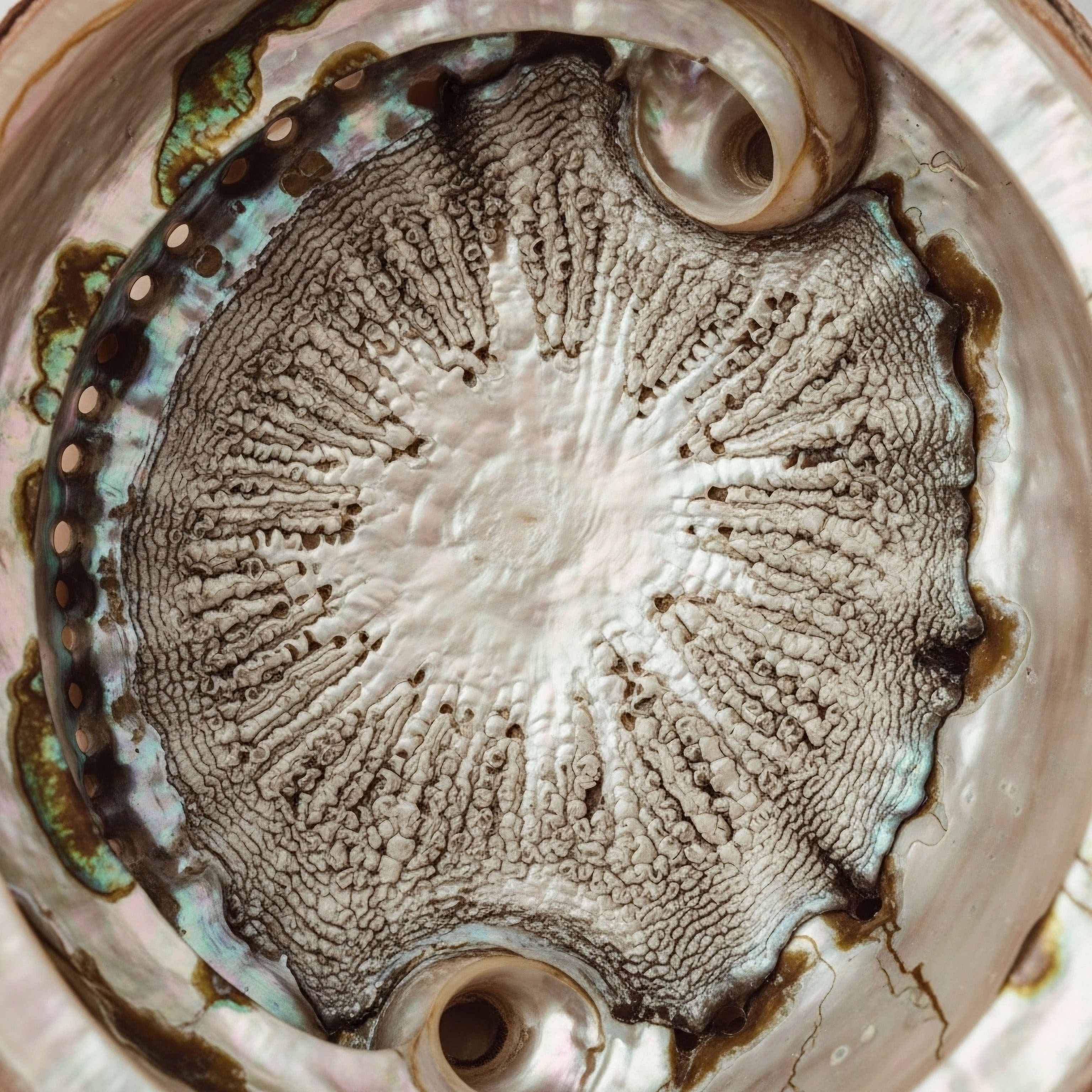

Fundamentals
The persistent feeling of exhaustion, a weariness that sleep fails to mend, is a deeply personal and often frustrating experience. You may feel as though you are doing everything right, yet vitality remains just out of reach. This sensation is a valid and important signal from your body.
It points toward a complex interplay within your internal ecosystem, specifically at the intersection of your hormonal health and the restorative quality of your sleep. Understanding this connection is the first step toward reclaiming your energy and function. Your body operates as an intricate network of communication, and hormones are the primary messengers carrying vital instructions to every cell.
Testosterone, in particular, is a powerful signaling molecule with a systemic role that extends far beyond its commonly known functions in muscle development and libido. It is a key regulator of energy, mood, cognitive function, and, critically, the very patterns of your nightly rest.
Sleep itself is a highly structured physiological process. It is composed of distinct phases, including light sleep, deep sleep, and Rapid Eye Movement (REM) sleep. Each stage serves a unique biological purpose. Deep sleep is essential for physical restoration and cellular repair, while REM sleep is vital for cognitive processing and memory consolidation.
The production and regulation of many hormones, including testosterone, are synchronized with this nightly cycle. The majority of daily testosterone release in men, for instance, occurs during sleep. Any disruption to this delicate architecture, whether through poor sleep habits or an underlying disorder, can interrupt this crucial hormonal production, creating a deficit that you feel acutely during your waking hours.
The relationship between testosterone and sleep is bidirectional; poor sleep can lower testosterone, and low testosterone can degrade sleep quality.
One of the most significant disruptors of sleep architecture is Obstructive Sleep Apnea (OSA). This is a condition characterized by repeated episodes of upper airway collapse during sleep. When the airway becomes blocked, breathing pauses, causing a drop in blood oxygen levels.
The brain senses this danger and briefly awakens you to resume breathing, a cycle that can repeat hundreds of time per night without your conscious awareness. These micro-arousals prevent you from entering and sustaining the deeper, more restorative stages of sleep.
The resulting sleep fragmentation and oxygen deprivation, known as hypoxia, place immense stress on the body. This chronic stress state directly interferes with the Hypothalamic-Pituitary-Gonadal (HPG) axis, the sophisticated feedback loop that governs testosterone production. Consequently, the presence of untreated OSA is a primary driver of low testosterone levels in many men.
This creates a challenging biological loop. Low testosterone can contribute to changes in body composition, such as increased body fat and reduced muscle mass, which are themselves risk factors for developing or worsening OSA. Simultaneously, the OSA actively suppresses the body’s ability to produce adequate testosterone.
Addressing one part of this cycle without considering the other often leads to incomplete solutions. Therefore, when considering a protocol like Testosterone Replacement Therapy (TRT), viewing it as a potential influence on this entire system is essential for a safe and effective outcome. The goal is to understand how optimizing hormonal levels interacts with the fundamental mechanics of sleep and respiration to restore systemic balance.


Intermediate
When an individual with clinically diagnosed hypogonadism begins a hormonal optimization protocol, the primary objective is to restore physiological balance and alleviate symptoms. A common therapeutic regimen for men involves weekly intramuscular injections of Testosterone Cypionate, often complemented by medications like Gonadorelin to support the body’s own hormonal signaling pathways and Anastrozole to manage the conversion of testosterone to estrogen.
While this biochemical recalibration can yield significant benefits in energy, mood, and physical well-being, its interaction with respiratory function during sleep demands careful clinical consideration. The core of this concern lies in how testosterone influences the complex systems that control breathing.

How Testosterone Influences Respiratory Control
The prevailing clinical evidence suggests that testosterone’s influence on sleep-disordered breathing is mediated through central neural mechanisms. The hormone appears to modulate the body’s chemosensitivity, which is its ability to detect and respond to changes in blood gases. Specifically, it can alter the ventilatory response to hypoxia (low oxygen) and hypercapnia (high carbon dioxide).
An altered response could mean that during an apneic event, the brain’s trigger to resume breathing is slightly modified, potentially affecting the duration or frequency of such events. This is a subtle but important distinction; the therapy influences the control system itself.
Another key area of investigation is testosterone’s effect on the neuromuscular function of the upper airway. The patency, or openness, of the throat during sleep is maintained by the tone of muscles like the genioglossus, the primary muscle of the tongue. Some evidence suggests that androgens can influence the contractility and endurance of these muscles.
A change in their behavior during sleep could theoretically alter airway collapsibility, a central feature of OSA. Therefore, initiating TRT in a patient with pre-existing, untreated severe OSA presents a potential risk of exacerbating the condition. Clinical practice guidelines from organizations like the Endocrine Society recommend screening for OSA before starting therapy and exercising caution, particularly in men with known severe sleep apnea.
Clinical protocols for testosterone therapy require careful screening for sleep apnea, as the hormone can modulate the neural and muscular systems that control breathing during sleep.

Clinical Monitoring and Protocol Adjustments
A responsible approach to hormonal optimization involves a structured process of evaluation and monitoring. Before initiating therapy, a thorough assessment should include questions about snoring, daytime sleepiness, and observed apneas. For individuals with a high risk or suggestive symptoms, a formal sleep study, or polysomnography, provides a definitive diagnosis and a baseline measure of OSA severity, typically quantified by the Apnea-Hypopnea Index (AHI).
- Baseline Assessment A comprehensive evaluation including symptom review and, if indicated, polysomnography to establish a baseline AHI and oxygen saturation levels.
- Patient Education A detailed discussion about the potential for TRT to influence sleep-disordered breathing and the importance of reporting new or worsening symptoms, such as increased snoring or daytime fatigue.
- Ongoing Monitoring Regular follow-up appointments to assess both the benefits of the therapy and any potential side effects. This includes monitoring hematocrit levels, as both TRT and OSA-induced hypoxia can lead to polycythemia (an increase in red blood cells).
- Treatment Synergy For patients diagnosed with OSA, the primary treatment is often Continuous Positive Airway Pressure (CPAP). Effectively treating OSA with CPAP can improve sleep quality, reduce hypoxia, and may even lead to a natural increase in endogenous testosterone levels. Managing both conditions concurrently is the standard of care.
Some research indicates that the impact of TRT on OSA might be time-limited. A randomized controlled trial noted an increase in AHI at seven weeks into therapy, but this effect was not statistically significant by the eighteenth week, suggesting a potential adaptive response in the body. This finding underscores the importance of continued monitoring, especially during the initial phase of treatment.

Comparative Risk Profile for TRT Initiation
| Patient Profile | Potential Benefits of TRT | Key Respiratory Considerations | Recommended Clinical Action |
|---|---|---|---|
| Hypogonadal Male, No OSA Symptoms | Improved energy, libido, mood, muscle mass, bone density. | Low initial risk, but new onset of snoring or fatigue should be evaluated. | Proceed with standard monitoring. Educate patient on OSA symptoms to watch for. |
| Hypogonadal Male, Untreated Severe OSA | Benefits are possible but are secondary to the primary health risk of OSA. | High risk of exacerbating AHI and nocturnal hypoxia. | Prioritize OSA treatment (e.g. CPAP). Re-evaluate for TRT once OSA is effectively managed. |
| Hypogonadal Male, OSA Treated with CPAP | Improved energy, mood, and metabolic parameters. May enhance tolerance and benefits of CPAP. | Low risk, as CPAP mechanically maintains airway patency, mitigating TRT’s potential effects. | Initiate TRT with standard monitoring. Confirm consistent CPAP usage. |


Academic
A sophisticated analysis of testosterone’s impact on sleep and respiration requires a systems-biology perspective, moving beyond a simple cause-and-effect model to appreciate the intricate feedback loops between the endocrine and respiratory control centers. The interaction is grounded in the neuro-endocrine modulation of chemosensitivity and upper airway neuromuscular integrity.
The core of the academic inquiry rests on how supraphysiological or even physiological restoration of androgens influences systems that have adapted to a state of hypogonadism, particularly in the context of the intermittent hypoxia characteristic of Obstructive Sleep Apnea.

How Does Testosterone Modulate Carotid Body Chemosensitivity?
The primary peripheral chemoreceptors responsible for detecting arterial hypoxia are the carotid bodies. These small, highly vascularized organs are critical for initiating the hypoxic ventilatory response (HVR), the reflexive increase in breathing when oxygen levels fall. Research indicates that the carotid bodies contain androgen receptors (ARs), suggesting a direct mechanism for testosterone to modulate their function.
Studies in animal models have shown that testosterone can potentiate the HVR. For instance, orchiectomy in rats has been shown to reduce resting ventilation, an effect that is reversed with testosterone replacement. One study demonstrated that testosterone supplementation in older male rats augmented the HVR, pointing to an age-dependent sensitizing effect.
This modulation presents a complex clinical picture. An overly sensitive HVR can contribute to respiratory instability and periodic breathing, a pattern often seen in sleep at high altitudes and in central sleep apnea.
In the context of OSA, a potentiated response to an apneic event could, in theory, lead to a more abrupt and forceful resumption of breathing, potentially creating oscillations in ventilatory drive that perpetuate further events. The human data remains somewhat enigmatic, with different studies reporting that TRT can increase, decrease, or have no significant effect on the HVR, a discrepancy likely attributable to differences in study populations, testosterone dosage, and duration of therapy.
Testosterone’s influence on respiratory stability is linked to its modulation of androgen receptors within the carotid bodies, the body’s primary sensors for blood oxygen levels.

Systemic Effects and Compounded Risks
The systemic effects of testosterone therapy can intersect with the pathophysiology of OSA in other significant ways. One of the most well-documented adverse effects of TRT is the potential for erythropoiesis, leading to an elevated hematocrit level (polycythemia). This increases blood viscosity and carries potential thrombotic risk.
Concurrently, the chronic intermittent hypoxia of OSA is itself a potent stimulus for erythropoietin production by the kidneys, also driving polycythemia. Therefore, initiating TRT in a man with untreated OSA can create a synergistic effect, compounding the risk of developing an abnormally high hematocrit. This highlights the necessity of viewing the patient as an integrated system, where interventions in one pathway have predictable consequences in another.
Furthermore, the relationship between sleep fragmentation, the Hypothalamic-Pituitary-Gonadal (HPG) axis, and cortisol output adds another layer of complexity. The sleep fragmentation inherent in OSA disrupts the normal circadian release of gonadotropin-releasing hormone (GnRH) and luteinizing hormone (LH), leading to suppressed testicular testosterone production.
This state of chronic stress also elevates cortisol levels. While TRT directly addresses the testosterone deficit, it does not correct the underlying sleep fragmentation or the abnormal cortisol rhythm. The interaction between exogenous testosterone and a dysregulated HPA axis is an area that warrants further deep investigation.

Summary of Key Clinical Research Findings
| Study Focus | Key Findings | Implications for Clinical Practice |
|---|---|---|
| Time-Limited Effects of TRT on OSA (Payne et al. 2021) | Measures of OSA (AHI) were elevated at 7 weeks of TRT but returned to non-significant levels by 18 weeks. | Suggests a potential for physiological adaptation to TRT. Heightened vigilance is required during the initial months of therapy. |
| Central Mechanisms of Action (Kim & Park, 2018) | TRT’s effect is likely mediated by central mechanisms affecting neural responses to hypoxia/hypercapnia and neuromuscular control, not by anatomical airway changes. | Focuses clinical concern on the control of breathing rather than physical obstruction, reinforcing the need for caution in patients with severe, untreated OSA. |
| Testosterone and HVR (Tatsumi et al. 1994; Fournier et al. 2014) | Animal studies show testosterone enhances the hypoxic ventilatory response and augments carotid sinus nerve output during hypoxemia. | Provides a plausible biological mechanism for how TRT can alter respiratory stability, mediated through androgen receptors on peripheral chemosensors. |
| TRT, OSA, and Polycythemia (Lundy et al.) | The development of polycythemia in men on TRT was associated with an increased prevalence of OSA. | Demonstrates a compounded risk, mandating hematocrit monitoring and underscoring the importance of treating OSA to mitigate hypoxia-induced erythropoiesis. |

References
- Payne, K. Lipshultz, L.I. Hotaling, J.M. et al. “Obstructive Sleep Apnea and Testosterone Therapy.” The Journal of Sexual Medicine, vol. 9, 2021, pp. 296-303.
- Kim, Won-Hee, and Jong Kwan Park. “Obstructive Sleep Apnea and Testosterone Deficiency.” World Journal of Men’s Health, vol. 36, no. 2, 2018, pp. 97-105.
- Bhasin, Shalender, et al. “Testosterone Therapy in Men With Hypogonadism ∞ An Endocrine Society Clinical Practice Guideline.” The Journal of Clinical Endocrinology & Metabolism, vol. 103, no. 5, 2018, pp. 1715-1744.
- Holloway, A.C. et al. “Testosterone Supplementation Induces Age-Dependent Augmentation of the Hypoxic Ventilatory Response in Male Rats With Contributions From the Carotid Bodies.” Frontiers in Physiology, vol. 12, 2021.
- La Vignera, Sandro, et al. “The complex relation between obstructive sleep apnoea syndrome, hypogonadism and testosterone replacement therapy.” Frontiers in Endocrinology, vol. 11, 2020, p. 543.
- Schneider, B. K. et al. “The role of testosterone in the respiratory and thermal responses to hypoxia and hypercapnia in rats.” Journal of Endocrinology, vol. 247, no. 1, 2020, pp. 1-13.
- White, D. P. et al. “Testosterone and the control of breathing during sleep.” Journal of Applied Physiology, vol. 59, no. 5, 1985, pp. 1614-1621.

Reflection
The information presented here illuminates the deep biological connections between your hormonal status, the quality of your rest, and the mechanics of your breathing. This knowledge serves a distinct purpose ∞ to equip you for a more substantive and collaborative dialogue with your healthcare provider. Your lived experience of fatigue or poor sleep is the essential starting point, and this clinical science provides the framework to investigate its origins.
Consider your body as a single, integrated system where no component operates in isolation. The path to sustained vitality is one of recalibrating that system. Understanding the potential interactions of any therapeutic protocol is the foundation of making informed, personalized decisions about your health. The ultimate goal is a protocol that is not only effective but is also synergistic with your body’s innate physiology, allowing you to function with renewed energy and clarity over the long term.



